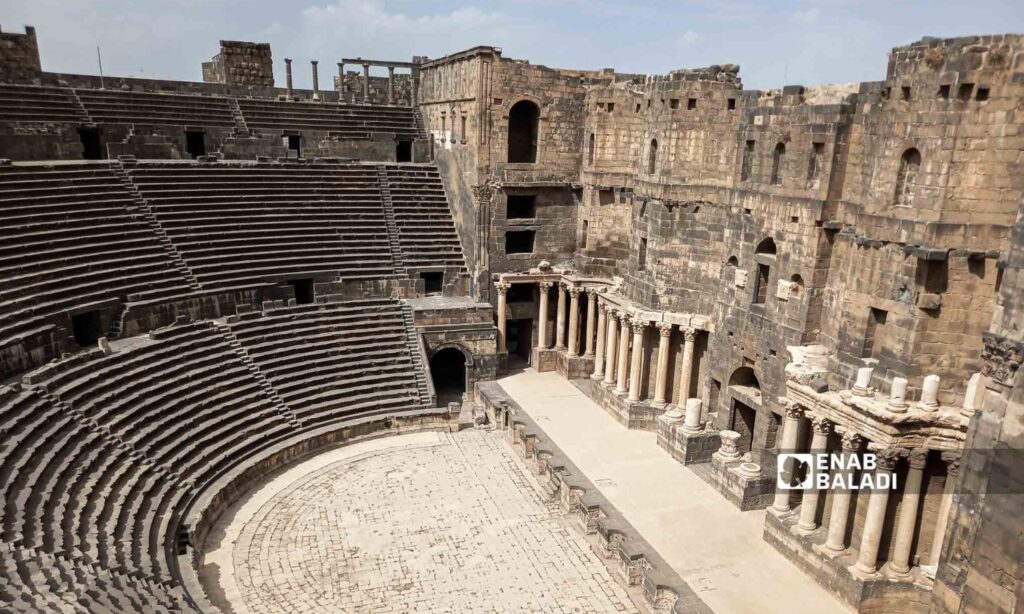Daraa – Halim Muhammad
On the side facing the Tal Shihab Falls in the western countryside of Daraa city, the 40-year-old Ghassan al-Omar stands and recalls his childhood trips to the area, where trees, water, and groups of tourists filled the place.
The tourist areas have become devoid of any movement after the drying up of their waters and the unjust cutting of trees. In addition, several factors have contributed to the deterioration of this sector, such as the poor security situation, the high costs of transportation, the flaccidity of state institutions, and the destruction of archaeological areas.
The tourism sector did not recover after the regime took control of the region in July 2018, despite the regime’s government promoting through several media outlets the return of life to normal in the southern Daraa region and all areas under its control.
Numbers are declining
A former director of the Daraa Tourism Chamber told Enab Baladi that the number of foreign tourists who visited the governorate in 2022 reached 3,000, while in 2010, the number reached 13,000 tourists who entered through the Nassib border crossing with Jordan.
The former official, who requested that his name not be revealed for security reasons, attributed the decline in tourism to several factors, including the drying up of water in surface lakes and springs, which used to attract tourists, especially from inside Syria.
He added that the state of security chaos has taken many tourist areas off the radar of tourists who fear assassinations, robberies, and theft.
Daraa witnesses dozens of assassinations every month amid the absence of regime authority in most areas of the governorate.
The Martyrs Documentation Office in Daraa documented 53 assassinations and attempted assassinations last October.
The former director of Daraa Tourist Chamber held the management of the Ministry of Tourism responsible for the slackness as a result of its lack of interest in the tourism situation in the governorate, its failure to attract tourism investments, and its failure to improve the descriptions of tourist areas.
Tourism affected by drought
For the third year in a row, the lakes of Muzayrib, Zayzoun, Oyoun al-Abd, and Tal Shihab Waterfalls dried up during the summer, making these areas lose the beauty of the view and the joy of swimming.
These areas were filled with tourists, especially from residents of neighboring areas in Daraa and from Damascus and other governorates, especially on official holidays.
Daraa-based Ghassan al-Omar told Enab Baladi that he used to go out with his friends on most Fridays, which are considered official holidays in Syria, during the summer in recent years.
Al-Omar explained that they used to spend all day under the trees around the lakes or inside the forests such as the Jalin forest, the Tseel forest, or the Jumla valley, but now he no longer goes out on trips because the area’s waters dried up and its trees were cut down, saying, “Previously we used to swim and ride boats in Lake Muzayrib, and all that remained are boats thrown on the shores of the lake.”
Among the factors that also affected the reality of tourism are the decline in purchasing power and the high cost of transportation.
Ahmed al-Radhi, 30, of Daraa city, told Enab Baladi that tourism has become a secondary matter in light of the deteriorating living conditions, as the head of the family has priorities that take precedence over going on outings, and he may need a work budget for an entire week.
Al-Radhi, who works in cell phone maintenance, explained that the price of a kilo of meat is 130,000 Syrian pounds as a minimum if the family wants to barbecue during the trip, while the bus fare is about 500,000 Syrian pounds if he rents it for a full day as he used to do previously, in addition to other expenses which is beyond his purchasing power.
The regime only exports Busra al-Sham’s Castle
After taking control of the southern region in July 2018, the regime began directing tourist delegations, especially foreign ones, to the ancient Busra al-Sham Castle and the Roman Theatre.
A number of residents of the city of Busra told Enab Baladi that Busra Castle is witnessing visits by foreign delegations accompanied by employees of the Ministry of Tourism, despite the continuing restoration operations and despite the castle not being ready to receive tourists, as the only hotel in the vicinity of the castle is still out of service after its destruction during the past years due to military operations.
The Syrian regime, through its media outlets, promotes the safe and normal state of life in Daraa and is keen to direct tourist delegations from foreign or Arab countries to visit the city while ignoring the rest of the tourist and archaeological sites, such as Muzayrib Castle and the Roman Bath in the city of Inkhil, the ruins of the town of al-Mataya, and Wadi al-Arais in the western countryside of Daraa.
The director of the Tourist Information Center in the city of Busra, Mohammad al-Miqdad, told the state-run news agency SANA last September that since last March, more than 25 tourist delegations of foreign nationalities have visited the city of Busra, in addition to more than 5,000 tourists on domestic tourist trips.
The ancient city of Busra al-Sham still suffers from neglect despite its entry into the UNESCO World Heritage Sites in 1980, and the United Nations did not contribute to the restoration operations, whether during the period of control of the opposition factions or even after the regime took control of the region.

